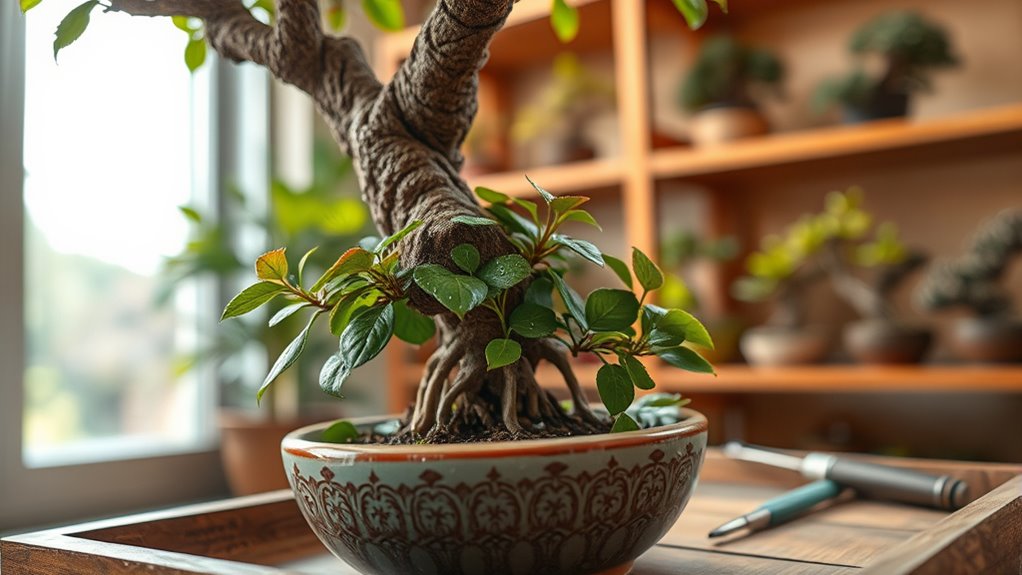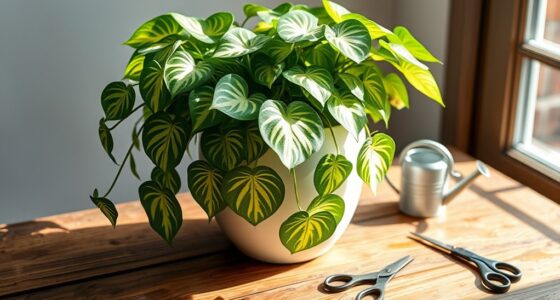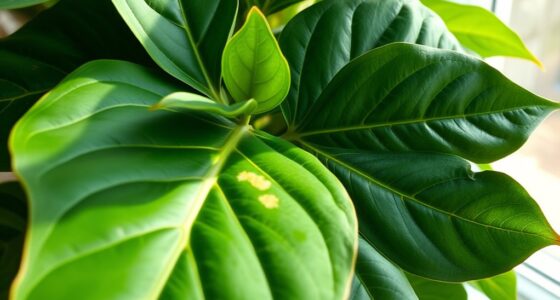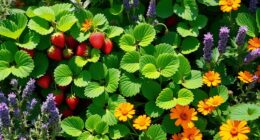To care for bonsai trees indoors, choose species like Ficus or Chinese elm that tolerate lower light and humidity. Place your bonsai near south-facing windows and supplement with grow lights if needed, keeping lights about 12-18 inches above. Maintain humidity at 50-60% with trays and misting, and keep temperatures stable around 20ºC. Water carefully, prune regularly, and repot when necessary. Proper pest control and seasonal adjustments help keep your bonsai healthy—continue to follow these tips for success.
Key Takeaways
- Place your bonsai near south-facing windows or use grow lights to ensure adequate natural or supplemental light.
- Maintain humidity levels around 50-60% with trays and misting, and keep indoor temperatures stable.
- Water the bonsai when the topsoil is dry, ensuring thorough watering without waterlogging for healthy roots.
- Use appropriate fertilizers during active growth and adjust watering and placement seasonally for optimal health.
- Regularly prune, wire, and repot to shape the bonsai and promote vigorous, healthy growth indoors.
Choosing the Right Indoor Bonsai Species

When selecting an indoor bonsai, it’s important to pick a species that thrives in your environment. Not all tree species adapt well to indoor conditions, so choose one that tolerates lower light and humidity levels. Using professional equipment such as grow lights can help compensate for limited natural sunlight. Additionally, understanding the flushing mechanisms of your bonsai’s native species can guide you in watering practices, ensuring the plant remains healthy without overwatering. Incorporating automation in care—like timed watering systems—can further help maintain proper moisture levels and reduce maintenance efforts. For beginners, hardy and forgiving species like Ficus bonsai or Chinese elm are ideal because they require less intensive care and are more adaptable to indoor temperature fluctuations.
Tropical and subtropical trees, such as Carmona, also do well indoors because they don’t need winter dormancy.
Schefflera (Hawaiian umbrella) can tolerate lower light and humidity, but shaping and wiring might be more challenging.
Ideal Placement for Your Bonsai Tree
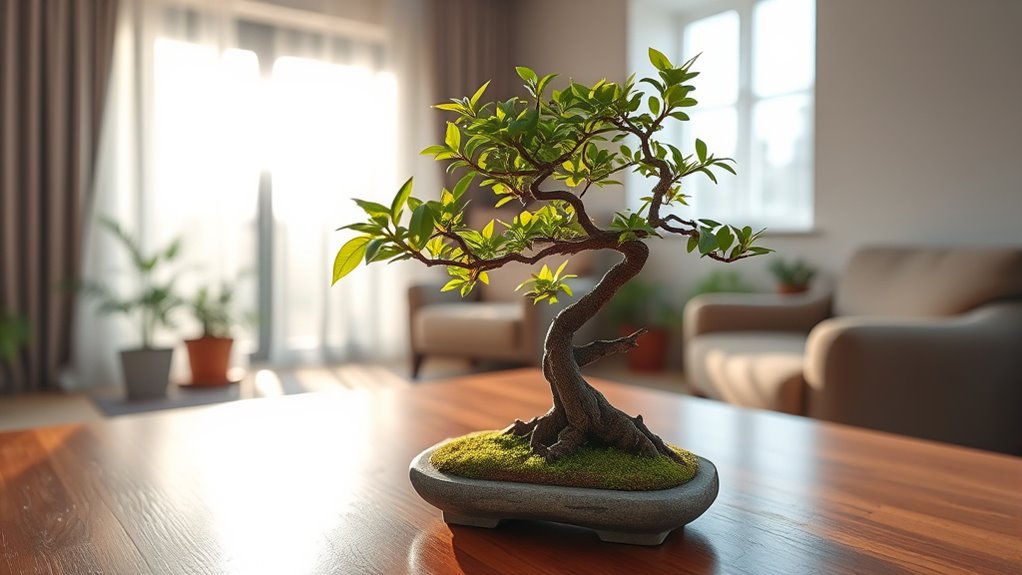
To guarantee your bonsai thrives indoors, placement is key. Indoor bonsai trees need ideal light exposure, so place them near a south-facing window to maximize sunlight during autumn, winter, and spring. Keep your bonsai away from heat sources like radiators, heaters, or vents to avoid temperature stress. In summer, move it outdoors or to a shaded, well-ventilated spot for better air circulation and light balance. Avoid drafts, air conditioning vents, and direct sunlight that can cause overheating or leaf scorch. Proper placement also helps maintain consistent humidity levels, which are crucial for your bonsai’s health. Additionally, rotate the tree periodically to ensure even light exposure and prevent uneven growth or leaning. This careful placement supports healthy growth and vibrant foliage. Proper placement also enhances the overall health of your bonsai by ensuring it receives the right environment for growth. Maintaining the correct environment is essential for healthy bonsai development and long-term vitality. Ensuring proper air circulation can further help prevent issues like mold or pests that may compromise your bonsai’s health. Additionally, understanding how light quality affects photosynthesis can lead to better placement decisions for optimal growth.
Managing Light and Artificial Illumination

To keep your bonsai healthy indoors, you need to optimize its placement for the best natural light. When sunlight isn’t enough, using grow lights such as LEDs can fill in the gaps, but you’ll want to balance natural and artificial sources carefully. Regularly adjusting your bonsai’s position guarantees it gets even illumination and promotes strong, healthy growth. Incorporating proper light exposure is essential for the overall health and development of your bonsai. Understanding the differences between natural and artificial lighting can help you create an optimal environment for your plant, including the use of LED grow lights for supplemental illumination when necessary. Additionally, selecting the right type of lighting modifications can further enhance your bonsai’s growth conditions.
Optimal Placement Strategies
For ideal growth, position your bonsai near a south-facing window to guarantee it receives plenty of natural sunlight, which provides the bright, direct light essential for healthy development. Proper indoor placement ensures your bonsai benefits from sufficient natural sunlight exposure, promoting strong, compact foliage. If natural light is limited, supplement with artificial grow lights such as LED or fluorescent lamps, aiming for about 10 hours daily. Be mindful of window orientation; avoid placing your bonsai in overly hot spots or near heat sources like radiators, which can stress the plant. During summer, move it slightly away from the window or to a cooler spot to prevent leaf scorch. Observe your bonsai’s response—healthy growth indicates ideal lighting conditions. Ensuring your bonsai receives appropriate light exposure is crucial for its long-term health and vitality. Additionally, incorporating indoor gardening techniques can help optimize light management and support your bonsai’s well-being. Proper light management also involves understanding the benefits of natural sunlight, which can enhance photosynthesis and overall plant health. Incorporating artificial lighting options can further ensure your bonsai thrives even in low-light environments.
Supplementing With Grow Lights
Since natural light may be limited indoors, supplementing your bonsai with artificial grow lights is essential for maintaining healthy growth. Using artificial lighting like full-spectrum LED or fluorescent grow lights helps guarantee your bonsai receives adequate light for photosynthesis. Incorporating Kia Tuning techniques, such as optimizing light placement, can further enhance overall health and growth. Aim for about 10 hours of consistent light daily to mimic outdoor sunlight, promoting strong foliage and healthy development. Position your grow lights roughly 12-18 inches above the bonsai to provide sufficient light intensity without risking heat stress. Regularly adjust the light duration and placement based on how your bonsai responds, ensuring it stays vibrant and well-shaped indoors. Proper artificial lighting creates an ideal indoor environment, encouraging steady growth and preventing etiolation caused by insufficient light. Additionally, understanding the light spectrum needed for optimal plant growth can help you select the most effective lighting options. Be aware that beauty store hours may influence where you purchase your grow lights, especially during holiday seasons or special sales.
Balancing Natural and Artificial Light
Balancing natural and artificial light is key to keeping your bonsai healthy indoors. Bright light, whether from south-facing windows or supplemented with artificial lighting like LED or fluorescent grow lights, supports proper sunlight exposure. Place your bonsai where it receives bright, indirect light, avoiding direct sun that can scorch leaves. During winter or in low-light environments, artificial lighting for about 10 hours daily is essential to sustain growth vigor. Use a light meter or observe leaf color and growth patterns to gauge if your bonsai gets enough illumination. If the leaves appear pale or the growth is weak, adjust placement or increase artificial lighting duration. Regularly monitoring the air quality around your bonsai can also help ensure optimal growing conditions, as poor air quality can impact plant health. Ensuring proper lighting conditions can significantly enhance your bonsai’s overall health and aesthetic appeal. Additionally, using artificial lighting with the right spectrum can promote healthy growth and development. Proper light spectrum is crucial for photosynthesis and overall plant vitality. Incorporating personal development techniques like mindful observation can help you better understand your bonsai’s specific needs and respond effectively. Striking the right balance ensures your bonsai remains healthy, vibrant, and well-developed despite indoor conditions.
Maintaining Proper Humidity and Temperature Conditions
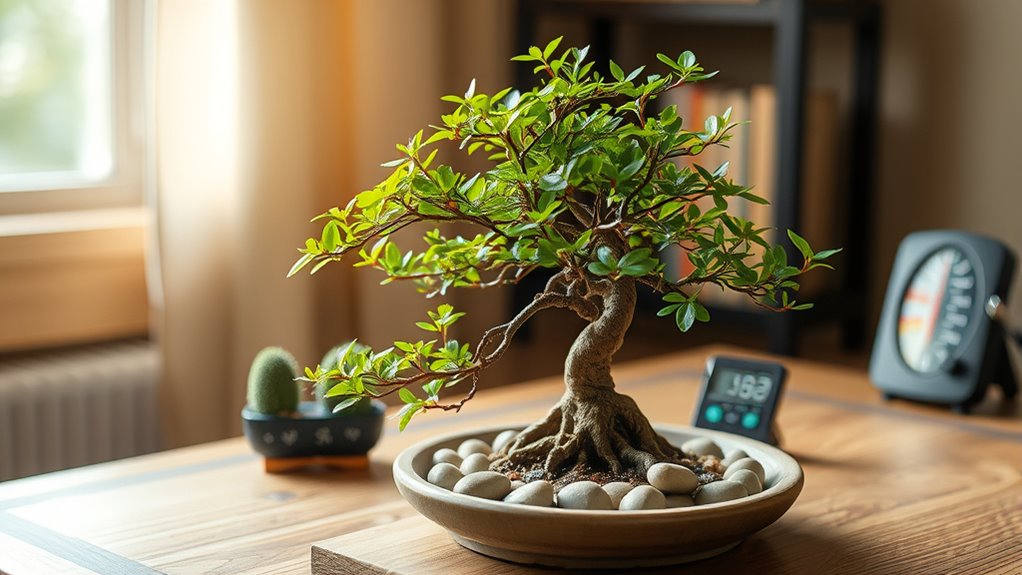
Maintaining proper humidity and temperature conditions is essential for the health of your indoor bonsai. Aim for humidity levels between 50-60%, which you can boost by placing a humidity tray filled with water and pebbles beneath your plant. Regular cleaning of nearby surfaces and the plant itself can also prevent dust buildup that might hinder growth.
Monitoring air quality indicators helps ensure your environment remains optimal for your bonsai’s wellbeing. Regularly mist the foliage to mimic natural dew and keep moisture around the leaves, especially in dry indoor conditions. Keep the room temperature stable around 20ºC (68ºF) for tropical species and protect subtropical varieties from cold drafts below 7ºC (45ºF).
Avoid placing your bonsai near heat sources like radiators or fireplaces, as they can cause temperature fluctuations that stress the plant. Improving air circulation by opening windows during the day also helps maintain consistent conditions and reduces stagnant air.
Watering Techniques and Soil Moisture Monitoring
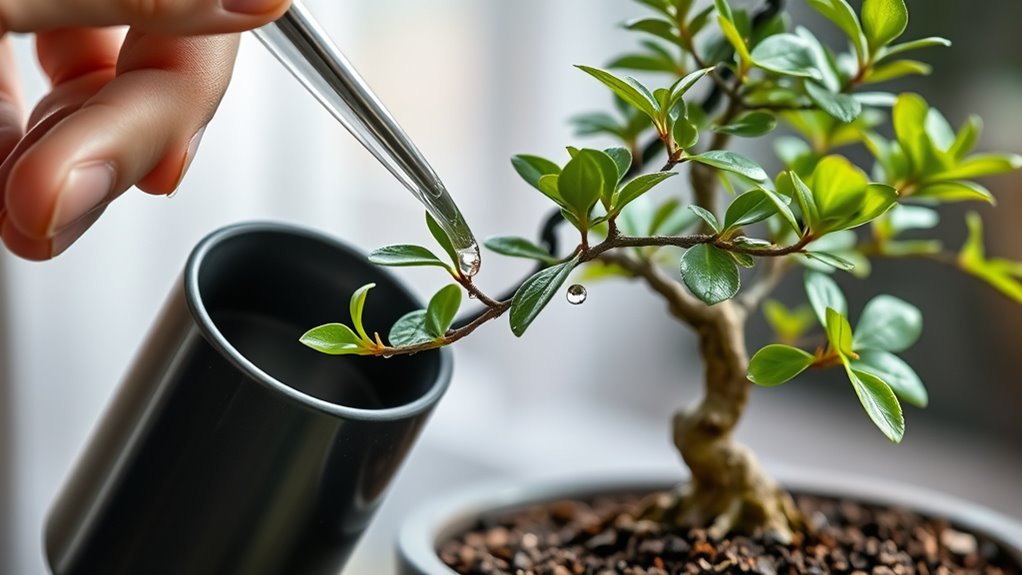
You should check the soil moisture daily by feeling the top inch. Water only when it feels dry and light brown.
When watering, do so thoroughly from above until excess drains out of the drainage holes to guarantee even saturation. Remember to avoid standing water and adjust your watering frequency based on indoor conditions like heat and dry air.
Checking Soil Moisture
Checking soil moisture regularly is essential to guarantee your bonsai receives the right amount of water. You can do this by lightly pressing your finger about one inch into the topsoil; if it feels dry or light brown, it’s time to water. Monitoring soil moisture helps you avoid over-watering or letting the soil dry out completely.
When watering, ensure you do so evenly from above until excess drains out of the drainage holes, thoroughly saturating the roots. Be attentive to dryness, especially in hot weather, when the soil may harden or become completely dry. If needed, submerge the pot in water for about 10 minutes to rehydrate the roots gently.
Regular checks keep your bonsai healthy and prevent issues caused by improper soil moisture levels.
Proper Watering Methods
To guarantee your bonsai receives adequate water, it’s important to use proper watering techniques that promote even moisture distribution.
Check the soil daily by feeling the top inch; water only when it feels dry and light in weight.
During watering, pour evenly onto the soil surface until it drains out of the bottom of the pot, ensuring thorough watering that reaches the roots.
Always empty excess water from the drip tray to prevent root rot.
Use rainwater if possible, but tap water is acceptable—just avoid boiling it, as that can harm the roots.
Adjust your watering schedule seasonally, increasing during active growth and reducing in dormancy, while regularly monitoring soil moisture to meet your bonsai’s water needs.
Fertilizing and Feeding Your Indoor Bonsai
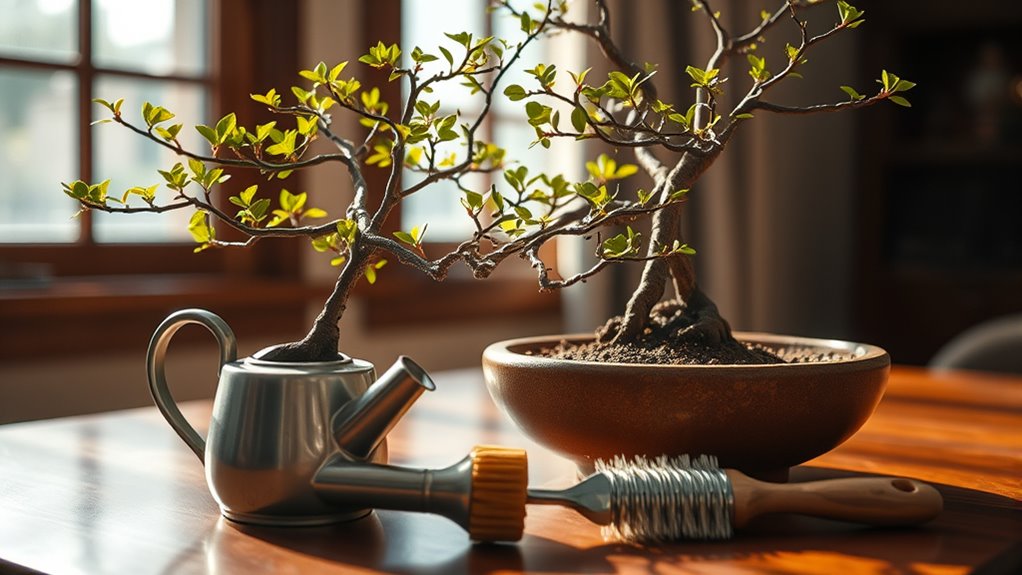
Feeding your indoor bonsai properly guarantees healthy growth and vibrant foliage. Use a diluted liquid fertilizer every two weeks during the active growing season to supply essential nutrients without overfeeding.
Feeding your indoor bonsai regularly keeps it healthy and vibrant year-round.
For granular fertilizers, press lightly into the soil surface every four to six weeks, adjusting based on your bonsai’s species and growth rate. Avoid fertilizing during winter dormancy, as growth slows and nutrients are less needed.
Choose a balanced NPK formula, like 7-7-7 or lower, to prevent nutrient excess and promote compact, healthy growth. Regularly monitor your bonsai for signs of nutrient deficiency, such as yellowing leaves, and adjust feeding accordingly.
Proper fertilizing ensures your indoor bonsai remains lush, strong, and thriving year-round.
Pruning, Shaping, and Training for Aesthetic Growth
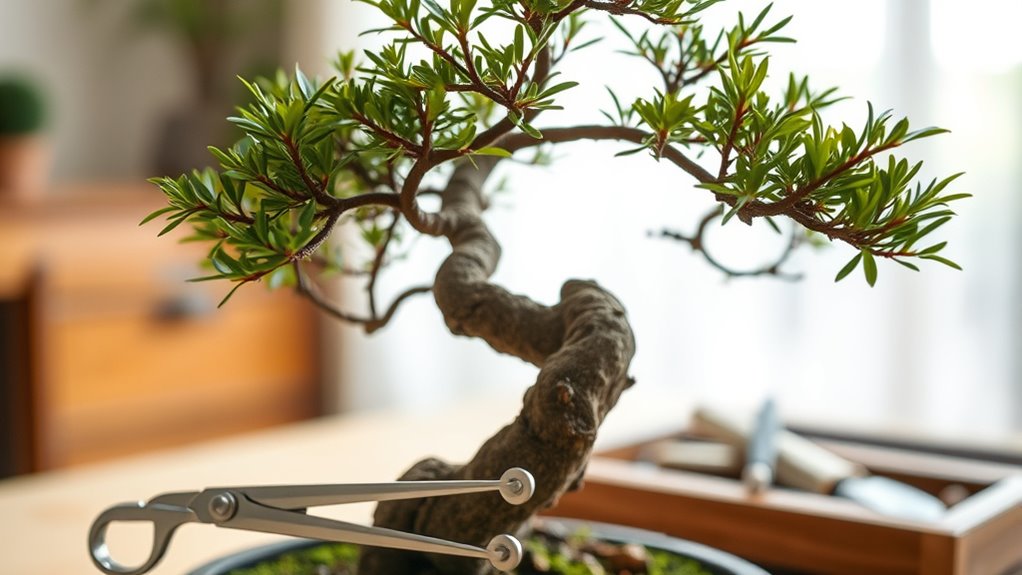
Pruning, shaping, and training are essential techniques to develop a visually appealing and well-balanced bonsai. Regular pruning of new shoots to one or two leaves encourages compact growth and keeps the shape refined.
Hard pruning and reshaping are best done in early spring before new growth begins, promoting healthy development.
Wiring branches with aluminum or copper allows precise shaping, but you need to monitor it regularly to avoid wire scarring or damage.
Trimming back to the first pair of leaves helps develop ramification, creating finer branches and a more detailed canopy.
Consistent trimming and training reinforce the bonsai’s structure, balance, and aesthetic harmony over time, ensuring your tree remains healthy and visually alluring.
Repotting and Root Care Procedures

Knowing when and how often to repot your bonsai is key to healthy growth; typically, every 2 to 5 years works best.
When repotting, carefully prune overgrown or circling roots with sharp scissors to stimulate new lateral roots.
Use a bonsai-specific soil mix and guarantee the root ball is positioned correctly to promote strong, stable growth.
Timing and Frequency
Timing your repotting and root care is essential for maintaining healthy bonsai trees indoors. Typically, young trees need repotting every 2 to 3 years, while mature ones can go 3 to 5 years.
The best time for repotting is in early spring before active growth starts. During this process, check the roots for signs of being root-bound; if they circle tightly, it’s time to repot.
Carefully prune any long or circling roots with sharp scissors, removing no more than one-third. When replanting, use fresh, well-draining soil and a slightly larger pot to promote healthy growth.
Remember not to fertilize for about a month after repotting, giving the roots time to recover and reducing stress on your bonsai.
Root Pruning Techniques
When it’s time to repot your bonsai, carefully remove the tree from its container to assess the root system.
Perform root pruning by gently trimming long or circling roots with sharp scissors, removing no more than one-third of the root mass.
Use a well-draining bonsai soil mix, such as pumice, akadama, and scoria, to promote healthy root growth and prevent waterlogging.
During root trimming, focus on cutting back the taproot and encouraging the development of fine lateral roots, which improve nutrient absorption.
After pruning, position your bonsai in a slightly larger pot, spreading the roots evenly before filling with fresh soil.
Water thoroughly to settle the soil and support root health, repeating this process every 2 to 5 years to maintain vigor.
Preventing and Addressing Pests and Diseases
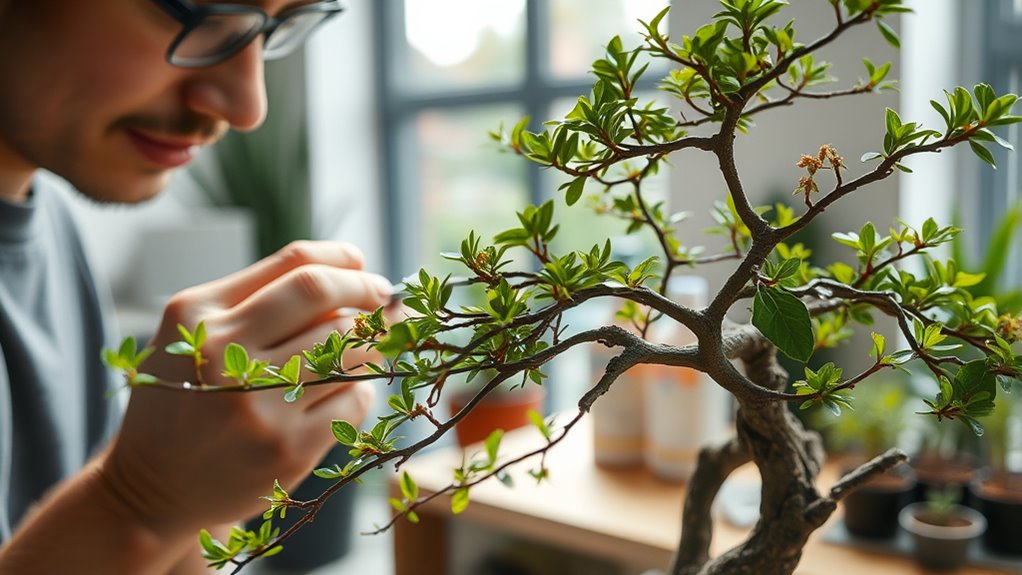
To keep your bonsai healthy, it’s essential to regularly inspect the leaves and stems for pests like scale insects, spider mites, greenfly, and fungus gnats, so you can catch infestations early. Pests can weaken your tree and spread fungal issues, which thrive in humid, poorly ventilated conditions.
Overwatering and poor drainage can lead to root rot, attracting fungal diseases that damage roots and overall health. To prevent problems, improve air circulation, reduce humidity, and apply targeted pest control or fungicide sprays when needed.
Fungus gnats are common pests that can signal overwatering, so adjust watering habits accordingly. Address fungal diseases promptly to avoid spreading and ensure your bonsai remains vibrant and resilient.
Regular vigilance and prompt action are key to healthy indoor bonsai care.
Seasonal Care and Adjustments for Indoor Bonsai

As the seasons change, your indoor bonsai needs different care routines to stay healthy and vibrant. During winter, reduce watering because lower indoor temperatures and shorter days slow growth and water needs.
Move tropical bonsai closer to windows or use supplemental grow lights to meet light requirements. Keep indoor temperatures steady between 15ºC and 20ºC to support dormancy and healthy growth cycles.
In summer, avoid direct hot sunlight and heat sources to prevent stress and leaf scorch. Adjust your fertilizer schedule accordingly: cut back during dormancy and increase during active growing seasons.
Also, consider repotting if your bonsai outgrows its container or needs fresh soil, ensuring it remains healthy year-round with proper seasonal care and adjustments.
Frequently Asked Questions
How Do You Keep a Bonsai Tree Alive Indoors?
To keep your bonsai alive indoors, you need to give it plenty of light, ideally from a south-facing window or artificial lights for about 10 hours daily.
Maintain high humidity with water trays and misting.
Water only when the topsoil feels barely damp, and keep temperatures stable around 20ºC.
Regular pruning, repotting, and checking for pests help make certain your bonsai stays healthy and vibrant.
How Often Should I Water a Bonsai Tree Indoors?
You should water your bonsai when the topsoil feels barely damp or light brown, typically every 1-3 days. Check the soil moisture daily, especially in warmer months or heated indoor environments.
Water thoroughly until excess drains out, ensuring even moisture without leaving roots in standing water.
Adjust your watering frequency seasonally, watering more during active growth in spring and summer, and less during winter dormancy, based on the soil’s moisture.
Why Are the Leaves on My Bonsai Tree Falling Off?
Your bonsai’s leaves falling off is like a silent cry for help, signaling imbalance. Overwatering drowns roots like a flood, while underwatering starves it dry. Sudden temperature shifts or drafts can shock the delicate balance, and low humidity leaves it parched.
Pests and diseases act as silent invaders weakening your tree. To revive it, check your watering habits, protect from drafts, and maintain proper humidity—your bonsai needs your attentive care.
How Do You Take Care of a Bonsai Tree for Beginners?
To care for a bonsai as a beginner, you should place it in a bright, south-facing window for plenty of sunlight, supplementing with artificial light if needed.
Water only when the soil feels barely damp, and avoid overwatering.
Mist daily to maintain humidity, prune regularly to shape the tree, and repot every 1-3 years using well-draining soil.
These simple steps keep your bonsai healthy and thriving.
Conclusion
With patience and care, your indoor bonsai becomes a living work of art, a tiny forest that breathes life into your space. Nurture it with the right light, water, and pruning, and watch it flourish like a miniature mountain landscape. Every careful decision is like tending to a delicate sculpture—each cut and adjustment shaping a timeless masterpiece. Keep your dedication steady, and your bonsai will reward you with endless beauty and serenity.
